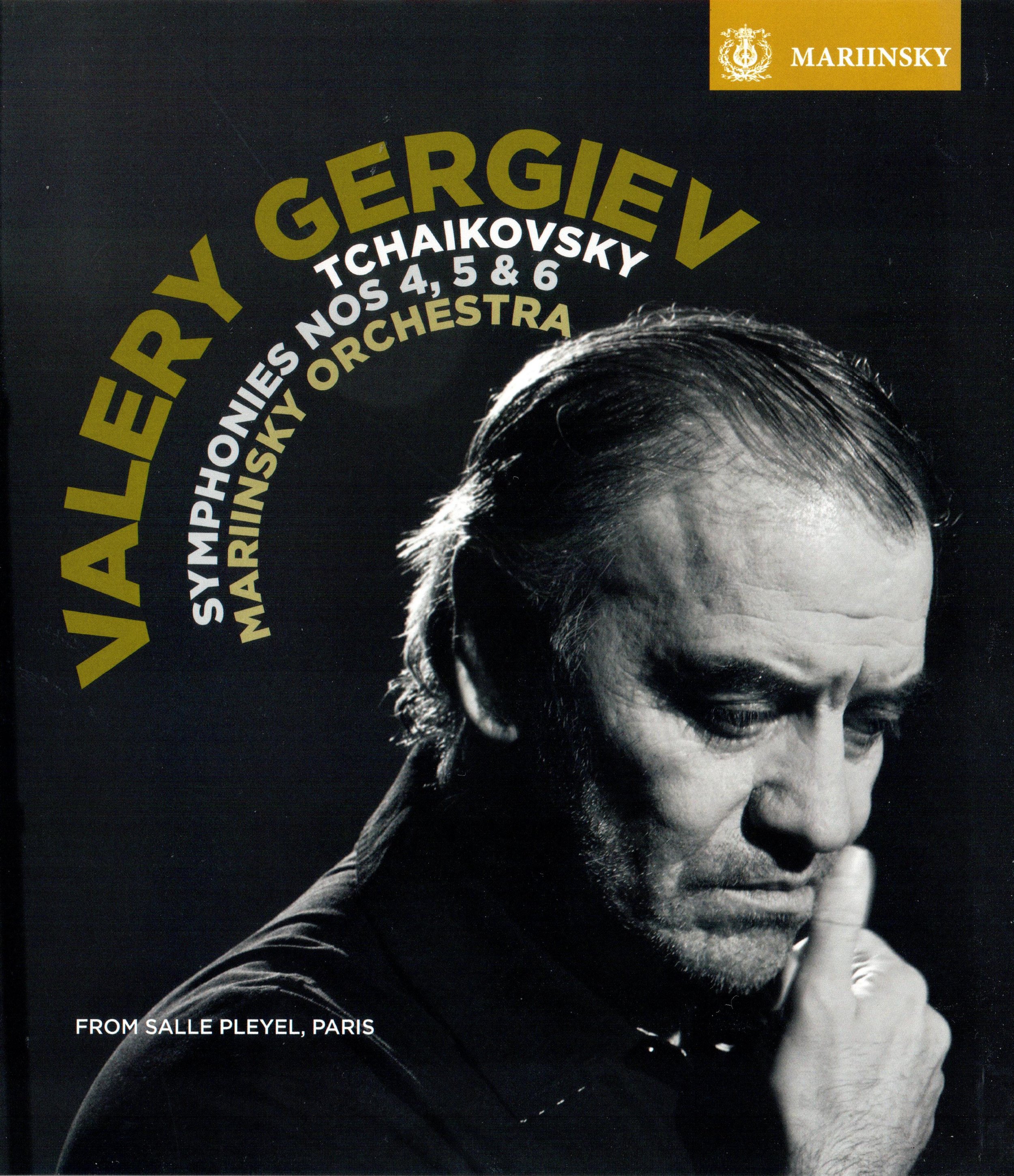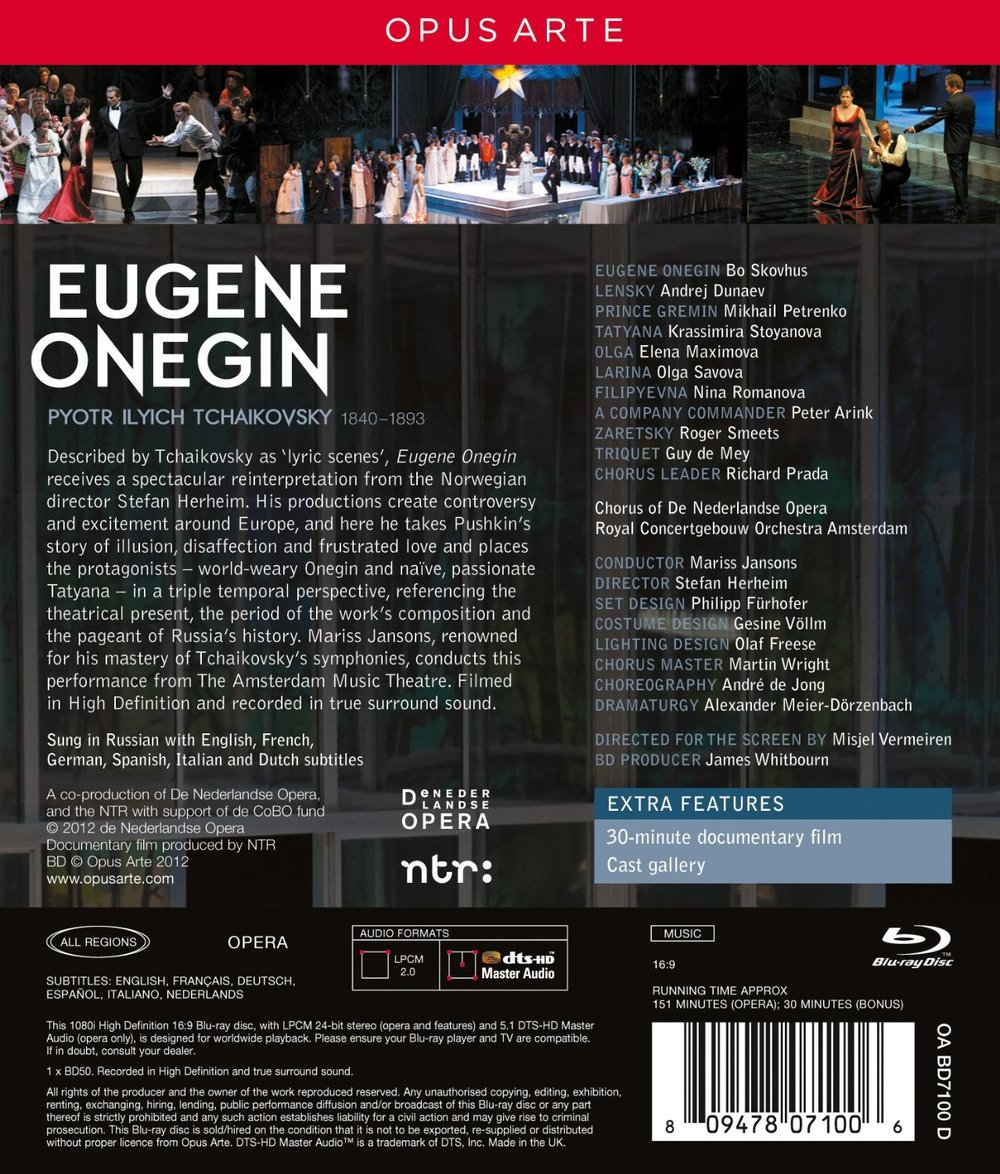

Tchaikovsky Symphonies Nos. 4-6. Valery Gergiev conducts the Mariinsky Orchestra in 2010 at Salle Pleyel in Paris. Three separate performances were directed for TV by Andy Sommer. Released 2011, disc has 5.1 dts-HD Master Audio sound. For all three tites: Grade: F
The musical performances at Salle Pleyel were probably quite enjoyable to the audience. But the SQ of the recording is poor compared to other HDVDs we have of the Tchaikovsky Symphony No. 6. Still, it's the video that tanks all three performances on this disc. I'll first describe in some detail the video recording of S4. The videos for S5 and S6 are similar with some differences I'll mention.
Tchaikovsky S4
The PQ of this Tchaikovsky S4 is almost astonishingly bad considering the fact that it was recorded in 2010. My theory is that the light at Salle Pleyel presented challenges the technicians could not overcome. Resolution is soft. Most frames are over-exposed, and the color balance is weirdly off with rose and yellow tones dominating. There is glare everywhere from the metal parts of instruments, the sheet music, and the white shirts. A white fog rises from the bottom of the picture from time to time. Many of the shots of the conductor have irritating motion artifacts. Many shots are plagued with focus and depth-of-focus issues.
Picture content is even worse than PQ because this video suffers from DVDitis with a wicked twist.
DVDitis is an illness that occurs when an HDVD is shot by folks who are used to making DVDs but don't know how to use high-definition TV cameras to make an HDVD. The main symptoms of DVDitis are lots of conductor shots used as a "hub" with many (easy-to-make) "spoke" shots of solo players, small groups of players, and instrument-only views, often in extreme close ups. In contrast to this, an HDVD with its high-definition pictures can present enjoyable views of large sections and especially the whole orchestra. (See our special article on standards for making a good HDVD of a symphony orchestra.)
The wicked twist here is that the Salle Pleyel supports a "spy cam" or mobile camera (probably on a wire) that looks down on the orchestra. This might sound like a useful capability. But as explained below, the spy cam just interferes with our enjoyment of the symphony.
The individual shots in this video are almost all very short. By the time the viewer gets oriented and is ready to enjoy a frame, a cut interferes and forces the viewer to focus on the next segment. There are no fewer that 73 conductor shots as the "hub" in this title. Then comes 53 instrument-only shots. There are 261 shots in the whole video. So already 48% of the video is accounted for without showing a player. Most of the rest of the video consists of shots of solos and small groups that can be done with close ups that look good on DVD. There are only 15 shots of whole sections and 15 shots of major parts of the orchestra.
That leaves us with about 20 whole orchestra shots. Of these, only 6 are traditional front-view, longer-range frames. The other 14 were made with the spy cam. When you see the whole orchestra from a seat in a theater, the group appears to be close together. When you see this from above with a spy cam, you realize that the orchestra a quite spread out. You are probably not used to this. The result is mental confusion and the need for time to get the images firmly in mind so you can observe and understand what you are seeing. But hold the phone! Already the spy cam is moving about or zooming in or out, which further interferes with your efforts to grasp what is happening.
The result of all this is that I found it wearisome to have to watch this Tchaikovsky S4. Still, to be fair, I did note some good shots. See 7:05 for a nice view of the bass violins and the 1st violins. I also liked a shot of the trombones and tuba at 9:28 and two traditional shots of the entire horn section at 18:24 and !8:39. There were two good spy cam shots of the cellos and winds at 9:25 and 9:36. But on the other hand, see the totally inane spy cam shot at 9:02 looking straight down on the tops of heads of a group of strings.
Tchaikovsky S5
For this title, the color balance was grayed down to a "sepia" look, possibly in a (substantially unsuccessful) effort to get rid of glare. I get the impression management was fiddling with the lights, and that the result was even more "hot spots" than before.
Tchaikovsky S6
Yet another change in color balance provides a "blue light" on the orchestra. Most other color is drained out. This may reduce glare a bit and resolution appears to be improved. But the musicians now all look quite grim—like characters in a horror movie where the "undead" play a symphony for an audience of seated frozen corpses. (See 1:51:47 for the corpses.) At 2:09:57 there is something new—a freeze frame of Gergiev's face. See 2:22:01 to 2:22:04 for a short segment where nothing is in focus. Finally, for maybe the worst shot ever published on an HDVD, see between 2:13:32 and 2:13:33. A camera was left on for a split-second while it was turned to the next subject in the shooting plan. You see 22 smeared shots (22 of 30 frames in a second) before the camera stops. This is a "blooper" rather than a weak shot. It should have been caught by the editor or later by whoever is in charge of quality control at Mariinsky.
Now for a grade: for weak sound, we go from an A+ to B. For bad PQ and video content, we drop from B to D. Finally, the poorly deployed spy cam and lack of quality control by Mariinsky leaves us with an F—this disc should have been abandoned and not sold to the public.
Below is a high-quality YT clip that clearly shows the DVD-like video content of this disc. However, the clip does not reveal the PQ issues I raise. But I have seen this title on 3 different high quality HT displays displays. Somehow the publisher managed to clean up the video on the YouTube segment, which I consider to be something like false advertisement. I wish the Blu-ray recording had been made with the same degree of care as this official clip:
OR




